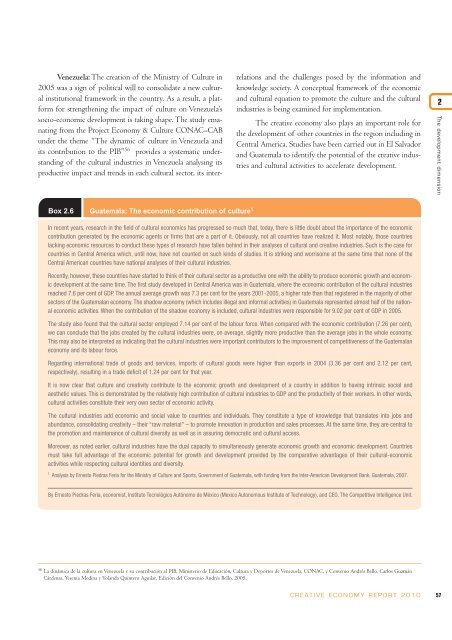Creative Economy: A Feasible Development Option
Creative Economy: A Feasible Development Option
Creative Economy: A Feasible Development Option
- No tags were found...
Create successful ePaper yourself
Turn your PDF publications into a flip-book with our unique Google optimized e-Paper software.
Venezuela: The creation of the Ministry of Culture in2005 was a sign of political will to consolidate a new culturalinstitutional framework in the country. As a result, a platformfor strengthening the impact of culture on Venezuela’ssocio-economic development is taking shape. The study emanatingfrom the Project <strong>Economy</strong> & Culture CONAC–CABunder the theme “The dynamic of culture in Venezuela andits contribution to the PIB” 56 provides a systematic understandingof the cultural industries in Venezuela analysing itsproductive impact and trends in each cultural sector, its interrelationsand the challenges posed by the information andknowledge society. A conceptual framework of the economicand cultural equation to promote the culture and the culturalindustries is being examined for implementation.The creative economy also plays an important role forthe development of other countries in the region including inCentral America. Studies have been carried out in El Salvadorand Guatemala to identify the potential of the creative industriesand cultural activities to accelerate development.2The development dimensionBox 2.6 Guatemala: The economic contribution of culture 1In recent years, research in the field of cultural economics has progressed so much that, today, there is little doubt about the importance of the economiccontribution generated by the economic agents or firms that are a part of it. Obviously, not all countries have realized it. Most notably, those countrieslacking economic resources to conduct these types of research have fallen behind in their analyses of cultural and creative industries. Such is the case forcountries in Central America which, until now, have not counted on such kinds of studies. It is striking and worrisome at the same time that none of theCentral American countries have national analyses of their cultural industries.Recently, however, these countries have started to think of their cultural sector as a productive one with the ability to produce economic growth and economicdevelopment at the same time. The first study developed in Central America was in Guatemala, where the economic contribution of the cultural industriesreached 7.6 per cent of GDP. The annual average growth was 7.3 per cent for the years 2001-2005, a higher rate than that registered in the majority of othersectors of the Guatemalan economy. The shadow economy (which includes illegal and informal activities) in Guatemala represented almost half of the nationaleconomic activities. When the contribution of the shadow economy is included, cultural industries were responsible for 9.02 per cent of GDP in 2005.The study also found that the cultural sector employed 7.14 per cent of the labour force. When compared with the economic contribution (7.26 per cent),we can conclude that the jobs created by the cultural industries were, on average, slightly more productive than the average jobs in the whole economy.This may also be interpreted as indicating that the cultural industries were important contributors to the improvement of competitiveness of the Guatemalaneconomy and its labour force.Regarding international trade of goods and services, imports of cultural goods were higher than exports in 2004 (3.36 per cent and 2.12 per cent,respectively), resulting in a trade deficit of 1.24 per cent for that year.It is now clear that culture and creativity contribute to the economic growth and development of a country in addition to having intrinsic social andaesthetic values. This is demonstrated by the relatively high contribution of cultural industries to GDP and the productivity of their workers. In other words,cultural activities constitute their very own sector of economic activity.The cultural industries add economic and social value to countries and individuals. They constitute a type of knowledge that translates into jobs andabundance, consolidating creativity – their “raw material" – to promote innovation in production and sales processes. At the same time, they are central tothe promotion and maintenance of cultural diversity as well as in assuring democratic and cultural access.Moreover, as noted earlier, cultural industries have the dual capacity to simultaneously generate economic growth and economic development. Countriesmust take full advantage of the economic potential for growth and development provided by the comparative advantages of their cultural-economicactivities while respecting cultural identities and diversity.1 Analysis by Ernesto Piedras Feria for the Ministry of Culture and Sports, Government of Guatemala, with funding from the Inter-American <strong>Development</strong> Bank, Guatemala, 2007.By Ernesto Piedras Feria, economist, Instituto Tecnológico Autónomo de México (Mexico Autonomous Institute of Technology), and CEO, The Competitive Intelligence Unit.56 La dinámica de la cultura en Venezuela y su contribución al PIB, Ministerio de Educación, Cultura y Deportes de Venezuela, CONAC, y Convenio Andrés Bello. Carlos GuzmánCárdenas, Yesenia Medina y Yolanda Quintero Aguilar, Edición del Convenio Andrés Bello, 2005.CREATIVE ECONOMY REPORT 201057
















